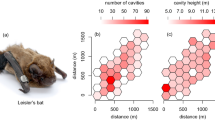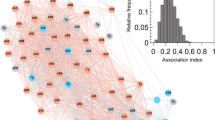Abstract
Animals often swarm and form communities to survive in harsh and complex environments. Toward improving the vulnerability of engineering systems against power-source limitations, we focused on food-sharing community of vampire bats (Desmodus rotundus). Although vampire bats die within 3 days if they fail to acquire any food, they can survive over 10 years by forming a highly sophisticated community wherein they share food with each other. In this study, we developed a simple mathematical model for the community formation process and demonstrated its validity via simulation.




Similar content being viewed by others
Explore related subjects
Discover the latest articles, news and stories from top researchers in related subjects.References
Camazine S, Deneubourg JL, Franks NR, Sneyd J, Bonabeau E, Theraula G (2003) Self-organization in biological systems, vol 7. Princeton University Press, Princeton
Liu J, Prindle A, Humphries J, Gabalda-Sagarra M, Asally M, Dong-yeon DL, Ly S, Garcia-Ojalvo J, Süel GM (2015) Metabolic co-dependence gives rise to collective oscillations within biofilms. Nature 523(7562):550
Graham JM, Kao AB, Wilhelm DA, Garnier S (2017) Optimal construction of army ant living bridges. J Theor Biol 435:184
Greenhall AM (2018) Natural history of vampire bats. CRC Press, Boca Raton
Wilkinson GS (1984) Reciprocal food sharing in the vampire bat. Nature 308(5955):181
Voigt CC, Kelm DH (2006) Host preference of the common vampire bat (Desmodus rotundus; Chiroptera) assessed by stable isotopes. J Mammal 87(1):1
Wilkinson GS (1986) Social grooming in the common vampire bat, Desmodus rotundus. Anim Behav 34(6):1880
Carter GG, Wilkinson GS (2015) Social benefits of non-kin food sharing by female vampire bats. Proc R Soc B Biol Sci 282(1819):20152524
Paolucci M, Conte R, Tosto GD (2006) A model of social organization and the evolution of food sharing in vampire bats. Adapt Behav 14(3):223
Kubo M, Sato H, Matsubara T, Melhuish C (2009) High survivability of a large colony through a small-world relationship. Artif Life Robot 14(2):168
Kubo M, Sato H, Matsubara T, Melhuish C (2008) Effect of network structure on the vampire bat energy sharing model. In: SCIS & ISIS, vol. 2008. Japan Society for Fuzzy Theory and Intelligent Informatics, pp 1876–1881
Witkowski M (2007) Energy sharing for swarms modeled on the common vampire bat. Adapt Behav 15(3):307
Di Tosto G, Paolucci M, Conte R (2007) Altruism among simple and smart vampires. Int J Coop Inf Syst 16(01):51
Wilkinson GS (1990) Food sharing in vampire bats. Sci Am 262(2):76
Wilkinson GS (1985) The social organization of the common vampire bat. Behav Ecol Sociobiol 17(2):123
Carter GG, Farine DR, Crisp RJ, Vrtilek JK, Ripperger SP, Page RA (2020) Development of new food-sharing relationships in vampire bats. Curr Biol 30(7):1275–1279
Carter GG, Wilkinson GS (2013) Food sharing in vampire bats: reciprocal help predicts donations more than relatedness or harassment. Proc R Soc B Biol Sci 280(1753):20122573
Carter GG, Wilkinson GS (2013) Cooperation and conflict in the social lives of bats. In: Bat evolution, ecology, and conservation. Springer, pp 225–242
Carter G, Wilkinson G (2013) Cooperation and conflict in the social lives of bats. Commun Integr Biol 6(6):e25783
Carter GG, Wilkinson GS (2016) Common vampire bat contact calls attract past food-sharing partners. Anim Behav 116:45
Carter GG, Logsdon R, Arnold BD, Menchaca A, Medellin RA (2012) Adult vampire bats produce contact calls when isolated: acoustic variation by species, population, colony, and individual. PLoS One 7(6):e38791
Kano T, Osuka K, Kawakatsu T, Matsui N, Ishiguro A (2017) A minimal model of collective behaviour based on non-reciprocal interactions. In: The 14th European Conference on Artificial Life, MIT Press, pp 237–244
Acknowledgements
The authors would like to thank Prof. Ken Sugawara of Tohoku Gakuin University and Associate Prof. Hiroki Takikawa of Tohoku University. This work was supported in part by the WISE Program for AI Electronics, Tohoku Universityy.
Author information
Authors and Affiliations
Corresponding author
Additional information
Publisher's Note
Springer Nature remains neutral with regard to jurisdictional claims in published maps and institutional affiliations.
This work was supported in part by the WISE Program for AI Electronics, Tohoku University.
About this article
Cite this article
Mikami, T., Kano, T. & Ishiguro, A. An agent-based model for community formation process of vampire bats that survive by sharing food. Artif Life Robotics 25, 561–568 (2020). https://doi.org/10.1007/s10015-020-00649-9
Received:
Accepted:
Published:
Issue Date:
DOI: https://doi.org/10.1007/s10015-020-00649-9




